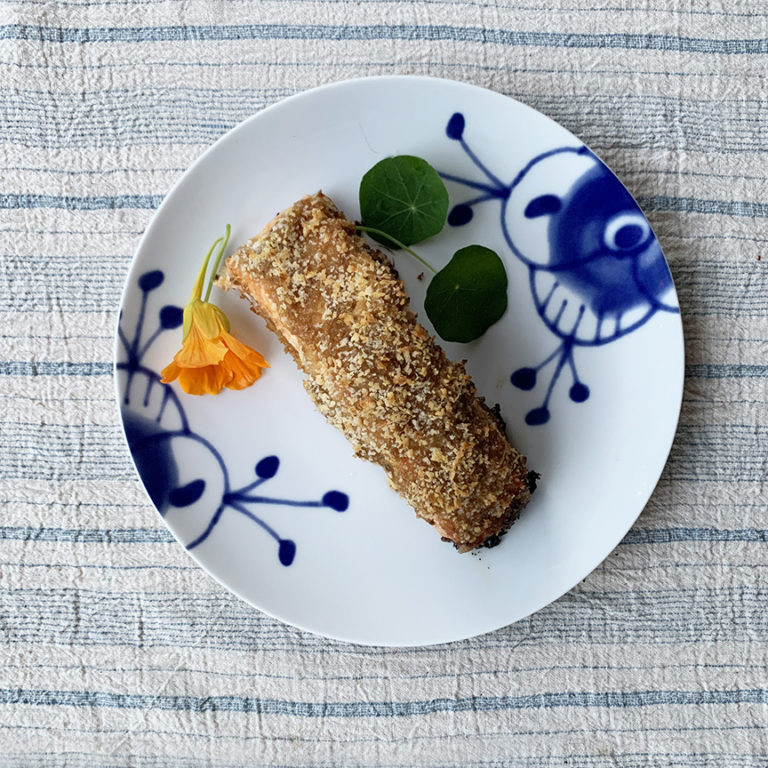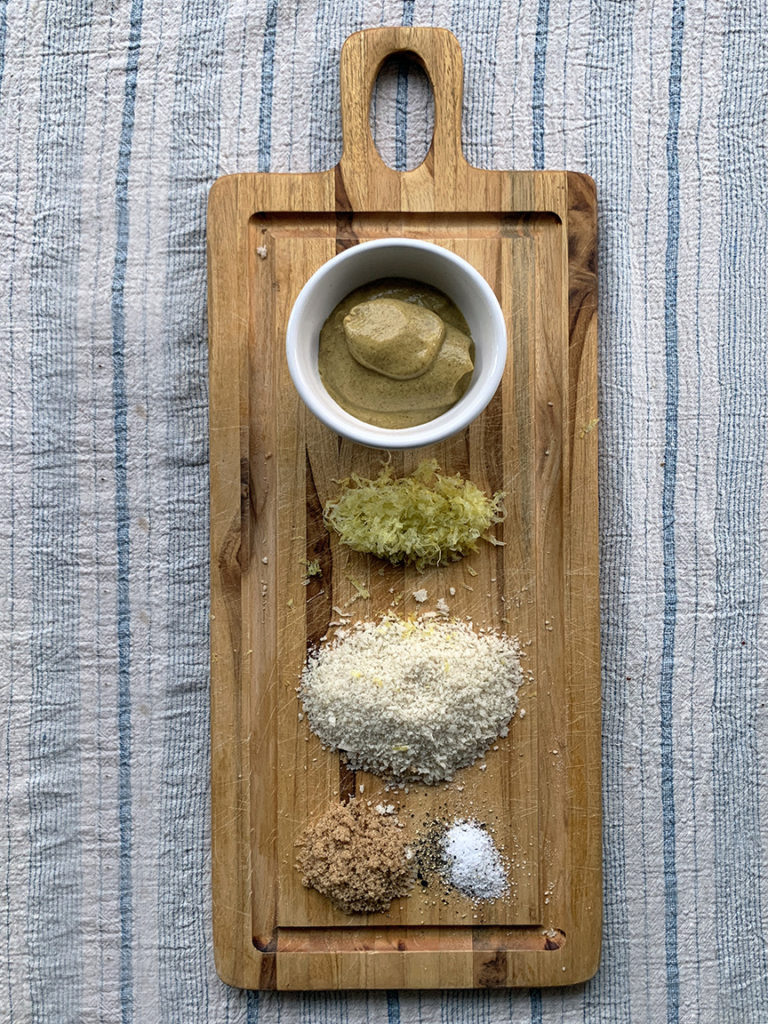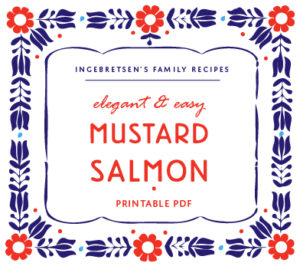Elegant and Easy Salmon Recipe

Ingebretsen’s is 100 years old this year. As part of the celebration, we’ve launched a blog series that features recipes from staff, teachers, and customers. We will also highlight food inspirations from some of our East Lake Street neighbors and some special recipes developed by author Anne Gillespie Lewis just for this purpose.
Good food was why Ingebretsen’s started in 1921 and it’s one of the joys of working at Ingebretsen’s in 2021. There is the constant presence of good food. Not just the Butcher Shop & Deli fare, but also what staff shares with one another. Birthday potlucks, people bringing what they baked the night before “just because,” the tasty extras from cooking classes and demonstrations – there’s always a steady supply of good things to eat.
One such good thing is the following recipe: Elegant and Easy Mustard Salmon. This dish is from Marian Nelson. Marian was a long-time Ingebretsen’s staff member, and though she is retired, her culinary legacy lives on at the store. She is known for taking great care with all her cooking and baking and some of the dishes she created have been just downright spectacular. A cook who can produce a poached salmon covered in thin slices of cucumber to mimic fish scales is a cook to be taken seriously. This recipe, however, is much simpler. (However, the result is so good that you may want to tell friends and family that you prepared this dish at great personal expense. We’ll keep your secret.)
Elegant and Easy Mustard Salmon
From Marian Nelson (find a printable pdf at the bottom of this post)
1 pound fresh salmon
Salt and pepper to taste
4 – 6 tablespoons Lars’ Own Swedish Spicy Mustard
Grated peel of half a lemon
1 tablespoon brown sugar
1 – 2 tablespoons Japanese-style (Panko) breadcrumbs
- Let salmon set at room temperature for 15 – 20 minutes. This helps the salmon bake more evenly.
- Preheat the oven to 450 degrees.
- Place a piece of parchment in the oven dish so that the bottom of the dish is covered. Grease the parchment lightly with vegetable oil.
- Salt and pepper the salmon. Place it skin-side down on the parchment.
- Mix the mustard and lemon peel. Spread the mixture so it completely covers the top of the salmon.
- Sprinkle brown sugar over the mustard topping so there is a light layer over the mustard sauce.
- Sprinkle the breadcrumbs so there is a light layer over all of the mixture.
- Bake for 20 to 25 minutes. The salmon is done if it flakes easily with a fork. Remove it from the oven while it is still moist. Let the salmon sit for ten minutes. It will continue to bake for several minutes outside of the oven, so it needs time to rest before serving.
One pound of salmon makes three servings. It’s a lovely, stress-free meal for entertaining. You can also flake the salmon and use it on a salad or a rice bowl. This recipe can be easily scaled up or down and it always looks attractive, so try using it in wraps, flaked over hash brown potatoes, or anywhere your creativity takes you.
Marian credits the original recipe to a Swedish friend, Karin Nordstrom, who prepared it when Marian and her husband were at her home for dinner. “It was so good, I told her I just had to have the recipe,” Marian said. Fortunately, Karin believes in sharing.
Marian suggests the following menu when serving Easy and Elegant Salmon:
– Creamed potatoes (boiled potatoes with a white sauce poured over them)
– Fresh green beans
– Lingonberries (of course!)
– Swedish Cole Slaw a la Marian Nelson
This is a “to taste” recipe, and not every ingredient has an exact amount. As you read this, make the voice in your head one that is warm and friendly, just as Marian was when dictating the following:
Shred one head cabbage and some carrots into a large mixing bowl. Add diced celery and green pepper to taste. Add salt and pepper, to taste.
Combine the following in a saucepan for the dressing:
½ cup cider vinegar
1 cup sugar
½ cup water
1 teaspoon dry mustard
Bring the dressing ingredients to boil until the sugar is completely dissolved. Cool. Once cool, pour over the vegetables, mix, and refrigerate for one to two hours. This slaw can be made well in advance and keeps for several days in the refrigerator.
– For dessert, Marion recommends almond cake.
A sterling attribute of this recipe is that it can be adapted to steelhead trout (if you’re unfamiliar with steelhead, they are firm and have a light pink color. You can pretend they’re salmon, just more affordable, especially for a crowd). It also works with canned salmon, which you can mold into balls or flatten into mini-fishcakes.
To make salmon balls: Mix one 1-pound can of drained salmon with the mustard, lemon, sugar, and bread crumbs. Add one egg. Mix with a fork.
Put a piece of parchment paper on a cookie sheet. Take a tablespoon of the mixture and roll into a ball. If the salmon is too wet, add more breadcrumbs. Place the salmon balls on the cookie sheet and bake at 350 degrees for fifteen to twenty minutes.
If you would like sauce for a finishing touch, take a quarter cup mayonnaise or Greek yogurt, stir in a squeeze of lemon juice and a tablespoon of finely chopped parsley.
To make mini-fishcakes: Blend everything together in a mixing bowl, including the egg. For more attractive fish cakes, cover the bowl and set in the refrigerator to chill for an hour. If you are hungry and impatient, simply continue on.
Heat a skillet over medium heat and generously coat the bottom with oil. Form the mini-fishcakes by taking one tablespoon of the salmon mixture. Roll it into a ball, then flatten it and place in the pan. Place as many in the pan as comfortably fits, with none touching each other and space for slipping a spatula underneath.
Cook for approximately 5 minutes, ensuring that they don’t stick by periodically putting the spatula under them and moving them slightly. Once the bottom is browned, flip the fishcake over and cook on the other side.
These won’t be as pretty as the salmon balls, but they have the added taste appeal of having been fried. Serve with the mayonnaise with lemon or try a Remoulade sauce. Remoulade is French in origin, but it has been enthusiastically adopted in Nordic countries.
We hope you’ll use Marian’s recipe to feed friends and family and as the template for creating a new recipe of your own. Please let us know the variations you create and let’s keep sharing good food ideas, even beyond our anniversary celebration.
Vær så god!

